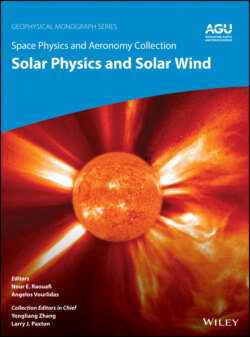Читать книгу Space Physics and Aeronomy, Solar Physics and Solar Wind - Группа авторов - Страница 13
1.1. INTRODUCTION
ОглавлениеOne of the current mysteries in heliophysics is the heating of the solar atmosphere to temperatures that are orders of magnitude hotter than the solar surface. As a result of this heating, the Sun cannot contain its atmosphere, and a continual outflow of plasma streams out from the solar corona to interplanetary space and beyond. For the debate surrounding the exact physical mechanisms of the heating of the corona, we direct the reader to Chapter 2. We here discuss the physical mechanisms behind the formation and propagation of the solar wind that are not yet well understood.
The whole volume of space influenced by the solar wind is called the heliosphere, and its size is in part modulated by the solar wind ram pressure. The solar wind extends from the corona to well beyond a hundred astronomical units (AU) to a termination shock. Beyond that shock, the solar wind slows down abruptly in response to the pressure of the interstellar medium, and the plasma becomes compressed and more turbulent until it reaches a zone where it can no longer push back the interstellar plasma. In situ measurements of these outer regions are sparse, and our exploration of this boundary layer has only just begun with the Voyager spacecraft. In particular, the global shape of the heliosphere is still not known because the Voyager has only measured a very small region of the heliospheric boundary.
Birkeland (1908) argued very early that a corpuscular emission from sunspots consisting of relativistic electrons must impact Earth’s magnetic field and be deflected to the polar regions to create the aurora. For several decades, it was realized that particles could be emitted from the Sun during flares, but it was generally thought that the space around Earth was mostly empty or perhaps traversed by occasional streams of particles from the Sun (Chapman & Ferraro, 1931). The prevailing view was that the solar corona consists of a hot gas (possibly extending to 1 AU), in thermal and hydrostatic equilibrium, pulled back by the solar gravitational field (Chapman & Zirin, 1957). Detailed observational studies of comets by Biermann (1951) showed that a subset of their tails cannot be accelerated by radiation pressure alone but may also respond to material flowing out from the Sun’s atmosphere. He suggested that the passage of solar particles at the comet formed an ion tail and that these particles must have a very high speed relative to the comet in order to align the tail in the Sun’s direction. Parker (1958) built on these observations and realized that the high temperature of the corona can provide enough energy to force coronal plasma to accelerate from subsonic to supersonic speeds. He demonstrated that the hydrostatic approach predicted too high kinetic pressure at infinity and that a continuous radial expansion of solar gas must act to reduce the coronal pressure. This was the first theory describing the continual expansion of what we now call the solar wind.
In this model, a dominant force affecting coronal particles and pushing them outward is induced by the thermal pressure gradient in the corona. Parker’s original model assumed an isothermal corona, but subsequent models allowing for a varying temperature with radial distance confirmed that a supersonic wind can also form under such conditions. The presence of an outflowing supersonic wind ranging from 300 to 800 km/s was confirmed by plasma measurements from the Luna 1, 2, 3; Venera 1; and Mariner 2 (e.g., Neugebauer & Snyder, 1962) and the numerous subsequent solar wind dedicated missions (e.g., Hundhausen & Gosling, 1976; Marsch et al., 1982). The Parker model provided an acceleration from subsonic speed in the coronal region to supersonic speeds of around 300–400 km/s typical of the slow solar wind. His model was unable, however, to explain fast solar wind speeds of 700–800 km/s without assuming unrealistic coronal hole temperatures in excess of 2 × 106K. As we shall show in this chapter, coronal and solar wind measurements suggest that additional physical mechanisms must be accounted for to produce a fast solar wind.
The solar wind has been measured in situ for several decades near 1 AU. Typical solar wind speeds near 1 AU range from 300 to 800 km/s, proton temperatures take values between 105 K in the slow wind to about 2 × 105 in the fast wind. There is now no doubt that the fast solar wind measured in situ originates near the center of coronal holes at the Sun (see Chapters 2 and 3). Coronal holes are cooler regions of the solar atmosphere that exhibit drops in Extreme UltraViolet (EUV) emissions. The cooler temperatures result from the significant escape of heat out in the solar wind. The fast solar wind streams out along open magnetic fields connecting regions deep inside coronal holes to the interplanetary medium. The origin of the slow wind is more complex and likely consists of multiple source components: these include transient releases from helmet streamers, plasma accelerating on rapidly expanding magnetic fields rooted at the boundary of coronal holes (through processes likely similar to that of the fast wind), and/or continual plasma exchanges between loops and open magnetic fields. We will describe these different components in the following sections.
